|
|
|
|
|
|
|
ShipShape
News,Tips and Happenings
|
|
|
|
|
Dear Shipmate:
|
While recently on vacation, Suzi and I had time to ourselves away from the hustle, bustle, phones and visitors at BlueJacket. We had the opportunity of examining the past 13 years, since we came out of retirement and purchased BlueJacket, and where we saw ourselves in the foreseeable future.
As much as we sometimes don't like to face reality, both Suzi and I are over 70. At some point, we really are going to have to slow down and retire for real this time. While we are both blessed with excellent health, we never can know what the future will be for us.
We both love BlueJacket. It has been everything that we hoped it would be; fascinating, a daily learning experience, and given us the opportunity of meeting and interacting with some of the nicest, most interesting people that it has been our pleasure to get to know.
Suzi and I have always prided ourselves on being honest and candid. We don't want to reach a point where something catastrophic happens to one or the other of us, and be in a panicked situation with BlueJacket. Very reluctantly, we have decided that now is the time to try to ensure an orderly transition for BlueJacket.
BlueJacket will be offered for sale and will be sold to a person(s) who cares deeply about the traditions, ethics and quality that have been BlueJacket's reputation for the last 108 years. If you happen to know of someone who might be a good candidate to continue BlueJacket, please ask him or her to contact me either by email ([email protected]) or by phone (800 448-5567). Our hope is for BlueJacket to continue and prosper for another 100 years.
I mentioned that Suzi and I recently got back from vacation, when we did all this heavy thinking. We went to China, simply because we were curious, like to travel, and had never been there before. 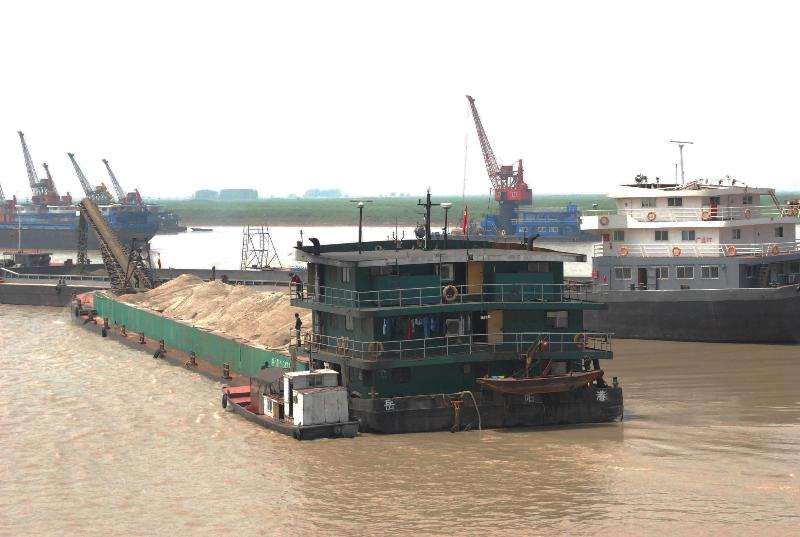 | barge traffic on the Yangtze River
|
Part of our time in China was 6 days aboard a Yangtze River boat, traveling between Wuhan and Chongqing, Szechuan. The Yangtze was absolutely filled with innumerable large steel motorized barges. Whole families live on these barges, and on one, we counted over 30 people. One of the more fascinating sights along the river were the multiple boat building operations, directly on the river banks, out in the open air! By the way, in answer to the question that many people have asked us, yes, the food was absolutely great and very spicy in Szechuan! But then again, we like Chinese food.
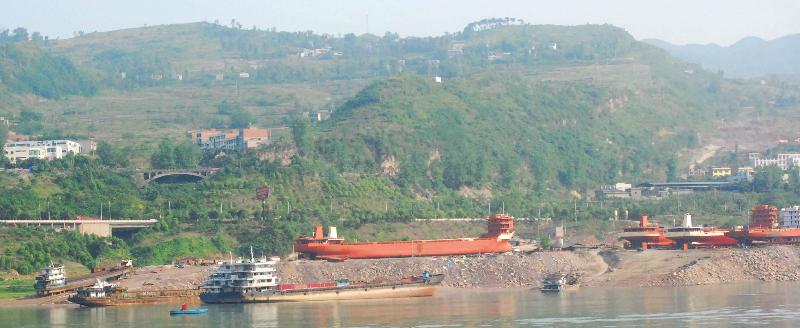 | |
boat building on the river bank
|
|
|
 |
|
|
Model of the Month-Lincolnville Wherry
|
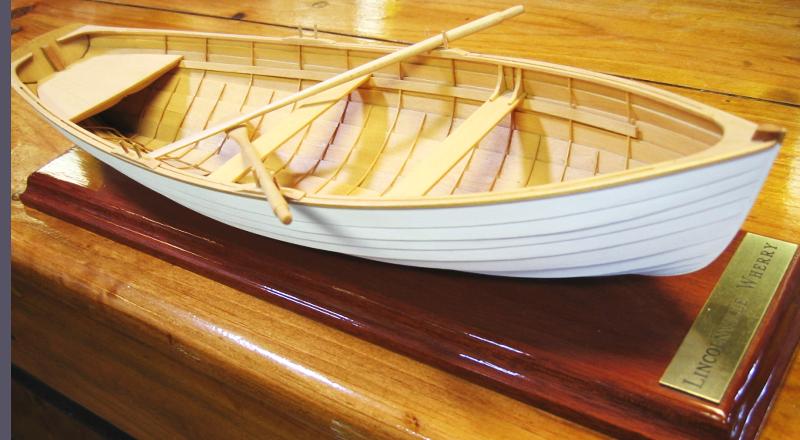
OK, before we even get started, what in the blue blazes is a wherry? No two "authorities" seem to agree as to what exactly constitutes a "wherry". So I'm going to tell you what I understand it to be.
A wherry is a small, light "pulling", i.e. row, boat. They are always lapstrake planked. This is also known as "clinker built". In this type of construction, the edges of the hull planks overlap. Wherrys probably were developed as water taxis on the Thames River, during Elizabethan times.
BlueJacket's Lincolnville Wherry (Item # KLW206) is a type of boat developed in the Lincolnville area of Penobscot Bay, Maine during the 19th century. This design concept was probably bought from Europe by the early Maine settlers. "Clinker's" were ideal for use in the in-shore salmon fishery that helped sustain Maine coastal communities during the 19th century. They were primarily used to set the salmon nets and to bring the trapped fish to shore. To the best of our knowledge, there is only one example of this type of wherry extant. It is on display at the Penobscot Marine Museum, in Searsport, ME and was built in 1913 by Mr. Emery Griffin of Lincolnville, ME. Of course, there may be other examples forgotten and rotting away in some old barn, but we certainly don't know of them. The 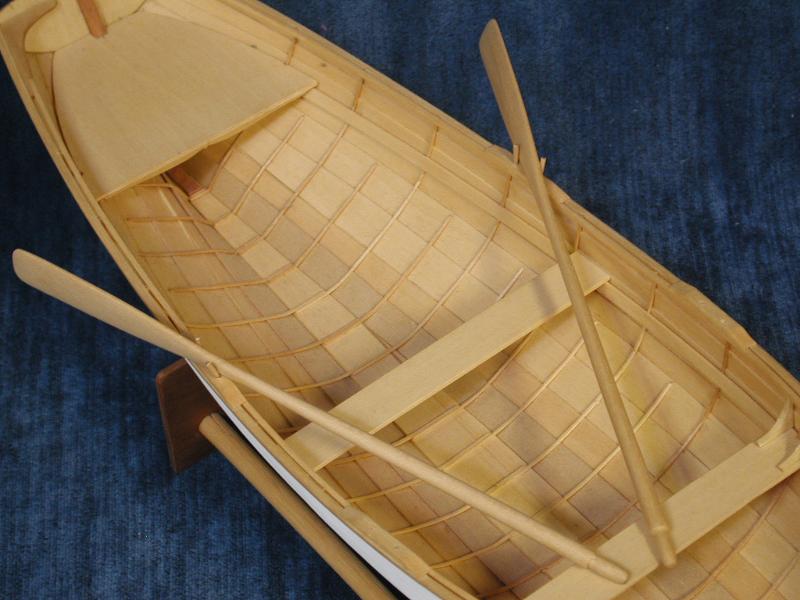 plans for BlueJacket's Wherry were obtained by measuring the hull lines and dimensions of the wherry in the museum. Originally built by lapstrake planking over naturally curved cedar ribs, these boats were unusually light and strong. Perfect for their intended use. BlueJacket's wherry model is absolutely exquisite. It is one of the models that Suzi and I have on display in our home. In general, it is constructed by first creating a building jig, out of supplied laser cut parts. Various other laser parts, such as the plank keel, stem, stern knee and strakes are built over the jig, which is later removed. The interior is then worked upon by installing the interior frames and various other parts. This is not an overly challenging project because of all of the provided laser cut parts, but it is most appropriate for a modeler with some previous experience in bending wood, planking, and doing detailed work. Upon completion of this project, you will have a true jewel of a model.
|
|
Tip of the month....Figureheads
|
Of all the wood carvings on an old sailing ship, nothing is more romantic and iconic than the ship's figurehead. Indian chiefs, Greek gods, dragons, nubile young women, kings, queens, animals....you name it and it probably has appeared  as a figurehead on some vessel or other. as a figurehead on some vessel or other.
Figureheads are the gaudily painted, larger-than-life carved images that are frequently found on the bow of sailing vessels. it is only good common sense that In seas populated by slimy sea monsters,whirlpools, mermaids, or anything else that might be imagined, a ship had to have some protection to keep it from falling off the edge of the world! Ancient seafarers like the Greeks, Chinese, Vikings and Phoenicians had to have protection from the unknown. A large, powerful idol on the bow cloaked the ship in it's protective mantle. Viking longboats had their snarling dragons, Romans had the "all-seeing" eye". Greeks had their ram's heads. More modern (16th-19th centuries) vessels had their kings, queens, heros, and owners depicted as the figurehead.
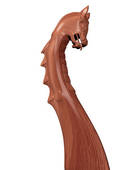 | Viking longship figurehead
|
Because they are so fascinating, we often lose sight of the fact that ship figureheads were mostly carved by shipwrights or ship's carpenters, not trained sculptors. That is part of their charm, as they are not constrained by scale or proportion and are usually painted in gaudy colors.
BlueJacket's wood of choice for model figureheads, as well as many other uses, is American basswood, which comes from the linden tree. It is our choice for the same reasons that duck carvers use basswood. It is the softest of the hardwoods, has a very close fine grain, and does not soak up glue or paint. It is also a relatively inexpensive wood. It is not perfect in that it the surface of the wood can be fuzzy which has to be dealt with. Boxwood is an alternative often used by expert wood carvers which is very hard and expensive, but in the right hands yields spectacular results.
 | | Dolphin figurehead |
I'm often asked about using a Dremel type power tool with which to carve.. As in most things, if it works for you, go for it. We don't use them for carving. It is my experience that a Dremel type tool, even at the slowest rpm's, is too fast to be able to control accurately. I'm told that some very fine carvers make use of old fashion belt driven dentist drills, mainly because they can be slowed down and easily controlled. We just do it the old fashioned way.
In this article, I'm not able to instruct you, step by step, on how to carve a figurehead. What it really takes is the desire to do so, a lot of practice, and if at all possible, a mentor to show you his tricks. Pick up a set of carving knives and gouges, some blocks of wood, plan a project, and then give it try. I bet that you'll be pleasantly surprised by the results.
|
|
Thanks for your support
|
My final message in these newsletters is always the same because it is the underlying truth to what we do and how we conduct ourselves.
In these really tough economic times, your support and words of encouragement mean more to us than ever before. They are very appreciated.
BlueJacket has been in business for over 100 years because what we do is fun, just as I have tried to make this newsletter. If you have any suggestions or comments, as always, just give us a shout!
Ain't nothin' we'd rather be doing than messing with, or talking about boats. Have fun!
Sincerely,

Jeff Marger
BlueJacket Shipcrafters, Inc.
|
|
|
|
|
|
|
|
|